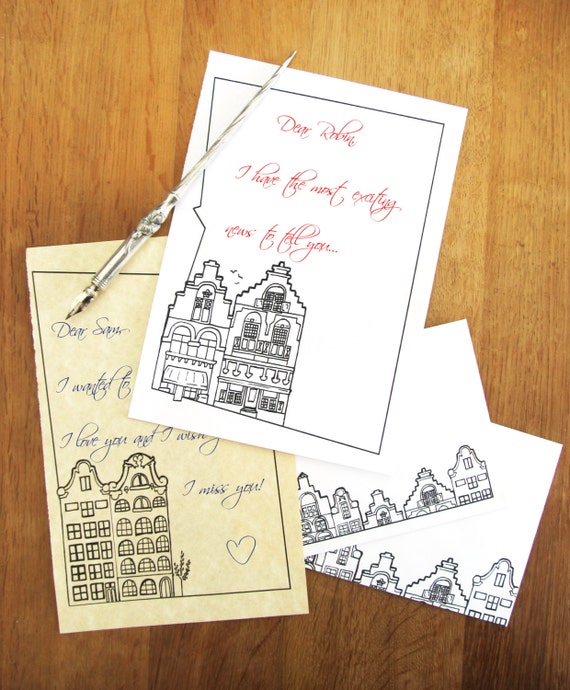 |
| Dutch City Houses Stationary available on Etsy |
I really enjoy simple line drawings, and all the funky building shapes you find around here lend themselves well to being outlined in ink. Earlier this week I was thinking about how I've written so many letters to friends that I am running out of my fancy stationary, and then I was struck by the inspiration to design my own writing paper with some Dutch city sketches. One of my friends is always asking me to send her drawings of what I see here, so I will! I went through my photos and picked out some distinctive looking buildings from Amsterdam, Utrecht, and Dordrecht, and put together a set of letterhead and envelopes.
Since I know I can't be the only one who still enjoys writing letters the old fashioned way, I've decided to try offering these as an instant download on Etsy (this is the first time I've used the download feature). I think the instant download option should work great for this kind of thing--not only can I skip having to deal with shipping, buyers can print as many copies as they want with one purchase! I also like the idea that everyone can customize their set with whatever paper color they want, add their name before printing, etc.
However, this isn't just an ad for what I'm selling on Etsy, honest! I started researching about the architecture as I paid more attention to the details.
Many of the distinctive buildings around here are from the 1600s, built with the wealth from the Dutch Golden Age. The designs are very symmetrical, which is pretty consistent with the Dutch sense of aesthetics. There are a few other common features that can be found when walking around the cities. First of all, as my Dutchman has informed me, any proper building is made from stone or brick. Secondly, they tend to be skinny, but tall enough for several stories, which I imagine (not being an architect) helps to have less roof to support and to also fit a dense population into a small area. Third, many have pointed tops that are created in various shapes. These tops are called gables, and the many variations are what form the unique rooflines seen here in the Netherlands and other places around Europe.
 |
| Stepped gables, Dordrecht |
The most common is a stair shape, known as a trapgevel in Dutch or crow-stepped gable in English. The trapgevel makes some sense since regular rectangle blocks can be used to form it, and Wikipedia suggests it made roof access easier (though that first step is a bit of a doosey!). The roof behind has a smooth slope so it makes me think of the false fronts found on some of the Old West buildings back home. This was popular from 1600-1665.
Dordrecht is also a great place to observe tilting buildings--that is, the fronts of the buildings are noticeably and purposely tilted towards the street. I've found several explanations for this. The most practical ones are that this helps rainwater drip away from the building, or it allows furniture to be hoisted up by a hook on top without bumping against the front (the stairways are too narrow to carry large furniture so some things were pulleyed up to the right floor). The less practical explanation is that it makes the buildings loom over you and seem more imposing and impressive.
 |
| Neck-gable, Utrecht |
A slightly different variation is the neck-gable, which is just one large step on top. It is tall enough to hide the steep roof behind it. These were built slightly later from 1640-1770.
 |
| Bell-gables, Amsterdam |
The bell-gable is a much smoother shape and I imagine more difficult to form. Many have fancy scroll designs outlining the bell, or other decorative facades. This design dates from 1660-1790.
 |
| Straight cornice, Utrecht |
Finally, there are also a number of straight cornices, with less decoration and no false front to hide the roof. These are typical of the 19th century.
Here are the sources I used to sound smart. Check them out to learn more about Dutch architecture!
ArtNetherlands.com
Architecture Around the World
European Architecture
Lovely! And I'm in love with Netherlands and especially with Amstredam!
ReplyDeleteThanks! Amsterdam does have some lovely old buildings, it's a fun city to walk through :-)
DeleteI have a passion for architecture and that's probably the reason why I'm finding your stationaries absolutely adorable. I hope those sell well on your etsy shop! Keep on letting your creative juices flowing! Good luck!
ReplyDeleteAdam Ithiel @ Marketing theProduct
Thanks, it's interesting to see how buildings have changed over the years!
DeleteThanks, it's interesting .restaurant spectacle Marrakech
ReplyDelete